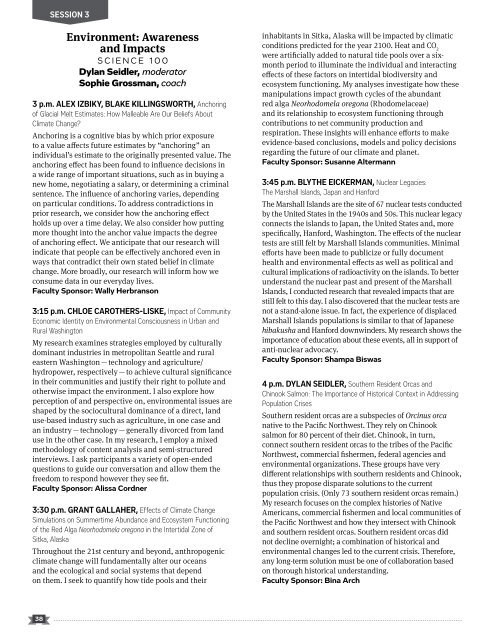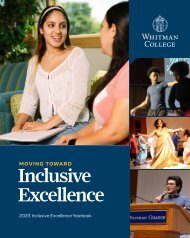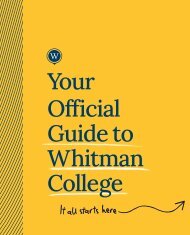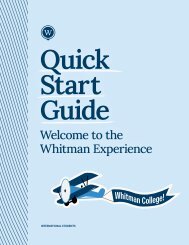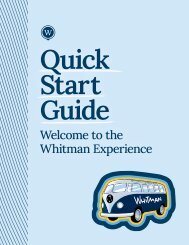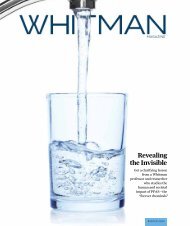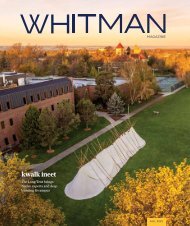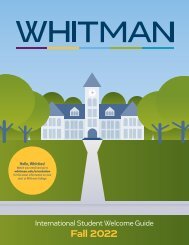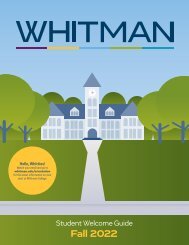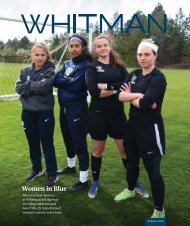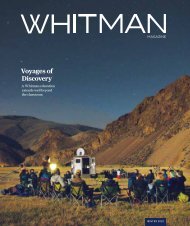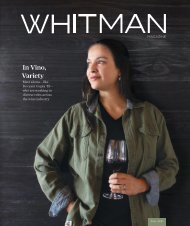Whitman College Undergraduate Conference Program 2020
Whitman College 2020 Undergraduate Conference Program
Whitman College 2020 Undergraduate Conference Program
Create successful ePaper yourself
Turn your PDF publications into a flip-book with our unique Google optimized e-Paper software.
SESSION 3<br />
Environment: Awareness<br />
and Impacts<br />
SCIENCE 100<br />
Dylan Seidler, moderator<br />
Sophie Grossman, coach<br />
3 p.m. ALEX IZBIKY, BLAKE KILLINGSWORTH, Anchoring<br />
of Glacial Melt Estimates: How Malleable Are Our Beliefs About<br />
Climate Change?<br />
Anchoring is a cognitive bias by which prior exposure<br />
to a value affects future estimates by “anchoring” an<br />
individual’s estimate to the originally presented value. The<br />
anchoring effect has been found to influence decisions in<br />
a wide range of important situations, such as in buying a<br />
new home, negotiating a salary, or determining a criminal<br />
sentence. The influence of anchoring varies, depending<br />
on particular conditions. To address contradictions in<br />
prior research, we consider how the anchoring effect<br />
holds up over a time delay. We also consider how putting<br />
more thought into the anchor value impacts the degree<br />
of anchoring effect. We anticipate that our research will<br />
indicate that people can be effectively anchored even in<br />
ways that contradict their own stated belief in climate<br />
change. More broadly, our research will inform how we<br />
consume data in our everyday lives.<br />
Faculty Sponsor: Wally Herbranson<br />
3:15 p.m. CHLOE CAROTHERS-LISKE, Impact of Community<br />
Economic Identity on Environmental Consciousness in Urban and<br />
Rural Washington<br />
My research examines strategies employed by culturally<br />
dominant industries in metropolitan Seattle and rural<br />
eastern Washington — technology and agriculture/<br />
hydropower, respectively — to achieve cultural significance<br />
in their communities and justify their right to pollute and<br />
otherwise impact the environment. I also explore how<br />
perception of and perspective on, environmental issues are<br />
shaped by the sociocultural dominance of a direct, land<br />
use-based industry such as agriculture, in one case and<br />
an industry — technology — generally divorced from land<br />
use in the other case. In my research, I employ a mixed<br />
methodology of content analysis and semi-structured<br />
interviews. I ask participants a variety of open-ended<br />
questions to guide our conversation and allow them the<br />
freedom to respond however they see fit.<br />
Faculty Sponsor: Alissa Cordner<br />
3:30 p.m. GRANT GALLAHER, Effects of Climate Change<br />
Simulations on Summertime Abundance and Ecosystem Functioning<br />
of the Red Alga Neorhodomela oregona in the Intertidal Zone of<br />
Sitka, Alaska<br />
Throughout the 21st century and beyond, anthropogenic<br />
climate change will fundamentally alter our oceans<br />
and the ecological and social systems that depend<br />
on them. I seek to quantify how tide pools and their<br />
inhabitants in Sitka, Alaska will be impacted by climatic<br />
conditions predicted for the year 2100. Heat and CO 2<br />
were artificially added to natural tide pools over a sixmonth<br />
period to illuminate the individual and interacting<br />
effects of these factors on intertidal biodiversity and<br />
ecosystem functioning. My analyses investigate how these<br />
manipulations impact growth cycles of the abundant<br />
red alga Neorhodomela oregona (Rhodomelaceae)<br />
and its relationship to ecosystem functioning through<br />
contributions to net community production and<br />
respiration. These insights will enhance efforts to make<br />
evidence-based conclusions, models and policy decisions<br />
regarding the future of our climate and planet.<br />
Faculty Sponsor: Susanne Altermann<br />
3:45 p.m. BLYTHE EICKERMAN, Nuclear Legacies:<br />
The Marshall Islands, Japan and Hanford<br />
The Marshall Islands are the site of 67 nuclear tests conducted<br />
by the United States in the 1940s and 50s. This nuclear legacy<br />
connects the islands to Japan, the United States and, more<br />
specifically, Hanford, Washington. The effects of the nuclear<br />
tests are still felt by Marshall Islands communities. Minimal<br />
efforts have been made to publicize or fully document<br />
health and environmental effects as well as political and<br />
cultural implications of radioactivity on the islands. To better<br />
understand the nuclear past and present of the Marshall<br />
Islands, I conducted research that revealed impacts that are<br />
still felt to this day. I also discovered that the nuclear tests are<br />
not a stand-alone issue. In fact, the experience of displaced<br />
Marshall Islands populations is similar to that of Japanese<br />
hibakusha and Hanford downwinders. My research shows the<br />
importance of education about these events, all in support of<br />
anti-nuclear advocacy.<br />
Faculty Sponsor: Shampa Biswas<br />
4 p.m. DYLAN SEIDLER, Southern Resident Orcas and<br />
Chinook Salmon: The Importance of Historical Context in Addressing<br />
Population Crises<br />
Southern resident orcas are a subspecies of Orcinus orca<br />
native to the Pacific Northwest. They rely on Chinook<br />
salmon for 80 percent of their diet. Chinook, in turn,<br />
connect southern resident orcas to the tribes of the Pacific<br />
Northwest, commercial fishermen, federal agencies and<br />
environmental organizations. These groups have very<br />
different relationships with southern residents and Chinook,<br />
thus they propose disparate solutions to the current<br />
population crisis. (Only 73 southern resident orcas remain.)<br />
My research focuses on the complex histories of Native<br />
Americans, commercial fishermen and local communities of<br />
the Pacific Northwest and how they intersect with Chinook<br />
and southern resident orcas. Southern resident orcas did<br />
not decline overnight; a combination of historical and<br />
environmental changes led to the current crisis. Therefore,<br />
any long-term solution must be one of collaboration based<br />
on thorough historical understanding.<br />
Faculty Sponsor: Bina Arch<br />
Great Performances<br />
KIMBALL THEATRE<br />
Ronja Mokranova, moderator<br />
Heleana Backus, coach<br />
3 p.m. MATT BIHRLE, Political Commentary Through Classical<br />
Music: Rzewski’s “Winnsboro Cotton Mill Blues”<br />
I perform Frederic Rzewski’s “Winnsboro Cotton Mill<br />
Blues,” a modern solo piano work based on a traditional<br />
blues of the same name. The original tune tells of the<br />
exploitative working conditions in the textile mills of<br />
North Carolina circa 1930. Conditions were hot, loud<br />
and inhumane. Entire families worked 60 hours a week,<br />
six days a week, for little pay. In this composition,<br />
Rzewski combines atonality, minimalism, blues and<br />
extended techniques to create an aural image of the mills.<br />
Mechanical rumblings in the bottom of the piano mimic<br />
the pounding of machines. The only respite from this<br />
unrelenting din comes from the voices of workers who<br />
sing a tranquil blues melody. Part of a set titled “North<br />
American Ballads,” Rzewski’s work takes an unflinching<br />
look at a troubling part of American history.<br />
Faculty Sponsor: Jackie Wood<br />
3:15 p.m. LIAM DUBAY, “Seven Sisters”: Character Piece for<br />
Clarinet, Cello and Piano<br />
“Seven Sisters,” composed for clarinet, cello and piano, is<br />
a character piece that depicts the Pleiades star cluster. The<br />
opening theme, voiced by solo cello, is constructed from<br />
two related seven-tone rows that are inverted, retrograded,<br />
transposed and otherwise altered throughout the course<br />
of the piece. The ensuing material is divided into seven<br />
distinct sections, each of which represents one of the<br />
Pleiades sisters from Greek mythology. Each brief section<br />
attempts to capture the essential character of one of the<br />
sisters, incorporating melodic and rhythmic elements<br />
from the main theme in the process. The first section,<br />
representing the eldest sister, Maia, is composed only<br />
of transformations of the main tone rows. The following<br />
sections equally employ all seven pitches from the theme,<br />
but more loosely than in the first section. Before the work<br />
is performed, I will speak briefly about the compositional<br />
techniques I employed in each variation.<br />
Faculty Sponsor: John David Earnest<br />
3:30 p.m. RONJA MOKRANOVA, “Different Worlds”: Suite for<br />
Flute, Cello and Piano<br />
“Different Worlds,” written for flute, cello and piano,<br />
comprises three movements and represents three<br />
perspectives on autism. The first movement is based on my<br />
father: a fast, rhythmically driven representation of family<br />
chaos caused by the unpredictable interactions of a father<br />
and his autistic son. A fragmented flute solo and sudden<br />
changes of meter augment the feeling of disorientation.<br />
The second movement depicts my mother and conveys<br />
pain, helplessness and hope. Lyrical themes supported<br />
by a gentle rhythmic figure in the piano characterize<br />
the opening section; an agitated middle section follows.<br />
The movement ends with a return to the lyricism of the<br />
opening. The third movement represents my brother: what<br />
the world looks like through the lens of autism. A sense of<br />
frustration is emphasized by rapid changes in dynamics<br />
and rhythmic energy. The purpose of my suite is to raise<br />
awareness of autism by sharing my family story.<br />
Faculty Sponsor: John David Earnest<br />
38 39


